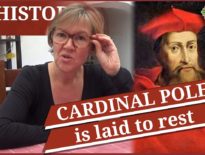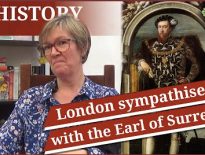On this day in Tudor history, 14th December 1558, Queen Mary I was buried at Westminster Abbey.
Mary had died on 17th November 1558 and had left instructions for Catherine of Aragon's remains to be moved from Peterborough and for them to be reinterred with Mary's remains so that mother and daughter could be together.
Did this happen?
Find out all about Mary I's burial, and who did join her in death, in today's talk.
Also on this day in history:
- 1542 - James V died at Falkland Palace in Falkland, Fife, Scotland, after being taken ill following the Scots' defeat at the Battle of Solway Moss on 24th November. His six-day-old daughter, Mary, inherited the throne, becoming Mary, Queen of Scots.
- 1562 – Death of William Grey, 13th Baron Grey of Wilton and military commander, during the night of 14th/15th December at the home of his son-in-law, Henry Denny, at Cheshunt in Hertfordshire. Grey served as a commander in the expedition to France in 1544, as Field-Marshal and Captain-General of Horse in Scotland in 1547, as a soldier in France in 1557, and as Warden of the Eastern and Middle Marches in 1559.
- 1563 – Baptism of Thomas Belson, Roman Catholic martyr, at Aston Rowant Church in Oxfordshire. He was hanged on 5th July 1589 for assisting the Catholic priests, George Nichols and Richard Yaxley, who were hanged, drawn and quartered on that day.
- 1563 – Burial of William Dacre, 3rd Baron Dacre of Gilsland and 7th Baron Greystoke, at Carlisle Cathedral.
- 1585 – Burial of Thomas Bentley, editor of “The Monument of Matrones: Conteining Seven Severall Lamps of Virginitie, or Distinct Treatises; Whereof the First Five Concerne Praier and Meditation: the Other Two Last, Precepts and Examples” (1582), a collection of prayers and meditations for and by women. It is said to be the first published anthology of English women's writing. Bentley was buried at St Andrew's, Holborn.
- 1592 – Death of Sir Roger Manwood, judge, member of Parliament and Elizabeth I's Lord Chief Baron of the Exchequer, in St Stephen's Parish, Hackington, near Canterbury.
- 1593 – Death of Henry Radcliffe, 4th Earl of Sussex, soldier, member of the Irish Privy Council, member of Parliament and patron of the Earl of Sussex's men. He was buried at Boreham in Essex.
- 1595 – Death of Henry Hastings, 3rd Earl of Huntingdon, administrator, diplomat, and military commander, at York. He was buried at St Helen's Church, Ashby-de-la-Zouch. Huntingdon was educated with the young Edward VI, and served in the household of Cardinal Reginald Pole, his great-uncle. He served Elizabeth I as President of the Council of the North, and was one of the peers at the trial of Mary, Queen of Scots in 1586.
- 1624 – Death of Charles Howard, 2nd Baron Howard of Effingham and 1st Earl of Nottingham, at Haling in Surrey. He was buried at Reigate Church in the family vault. Nottingham served Elizabeth I and James I as Lord High Admiral, and commanded the English forces against the Spanish Armada in 1588.
Transcript:
On this day in Tudor history, 14th December 1558, just under a month after her death, Queen Mary I, daughter of King Henry VIII and his first wife, Catherine of Aragon, was buried at Westminster Abbey.
Mary who had only reigned for just over five years, had died on 17th November 1558, and her half-sister, Elizabeth, had become Queen Elizabeth I.
Although Mary had left instructions in her will for her mother Catherine of Aragon's remains to be exhumed and brought to London, so that mother and daughter could be buried together, her instructions were ignored. Mary was buried by herself at Westminster, with just stones marking her resting place.
On 13th December 1558, Mary’s remains had been processed from St James’s Palace to Westminster. In his diary, Henry Machyn, a merchant tailor and citizen of London, recorded that her coffin was carried by chariot and there was a painted effigy of her, which he described as “adorned with crimson velvet and her crown on her head, her septre on her hand, and many goodly rings on her fingers.
Machyn records that at the door of the abbey, Mary’s coffin was met by “4 bishops and the abbot, mitred in copes and incensing the body”. Her remains lay there “all night under her hearse, and her grace was watched. And there were a hundred poor men in good black gowns bearing long torches, with hoods on their heads, and arms on them; and a-bout her the guard bearing staff-torches in blake coats; and all the way chandlers having torches, to give them that had their torches burnt out.”
Mary was buried the following day, this day in 1558, and Machyn records her funeral in his diary too:
“The 14 day of December was the queen’s mass; and all the lords and ladies, knights and gentlewomen, did offer. And there was a man of arms and horse offered; and her coat of armour, and sword, and target, and banner of arms, and 3 standards; and all the heroldes about her; and there my lord bishop of Winchester made the sermon; and there was offered cloth of gold and velvet, whole pieces and other things.
After the mass all done, her grace was carried up to the chapel the king Henry the VII builded, with bishops mitred; and all the officers went to the grave and after they break their staves, and cast them in-to the grave; in the mean time the people plucked down the cloth, every man a piece that could catch it, round a-bout the church, and the arms. And afterwards, my lord bishop of York, after her grace was buried, he declared a collation, and as soon as he had made an end, all the trumpets blew a blast, and so the chief mourners and the lords and knights, and the bishops, with the abbot, went in-to the abbey to dinner, and all the officers of the queen’s court.”
In 1606, in the reign of King James I, Elizabeth I’s remains were moved from their resting place in Henry VII's vault to join her sister Mary’s remains. James I erected a monument bearing Elizabeth I’s effigy, but not one of Mary, and the Latin inscription on the monument can be translated as:
“Partners both in throne and grave, here rest we two sisters, Elizabeth and Mary, in the hope of the Resurrection.”



This was a beautiful and regal and correct royal funeral and procession and Mary was properly honoured.
What a great shame that she was denied a monument. I know it might have been cost but it was also biased and she deserves a monument.
If I had the money I would pay for one for her and although I would leave Katherine in Peterborough, one for her as well. I happen to like where Katherine of Aragon is buried.